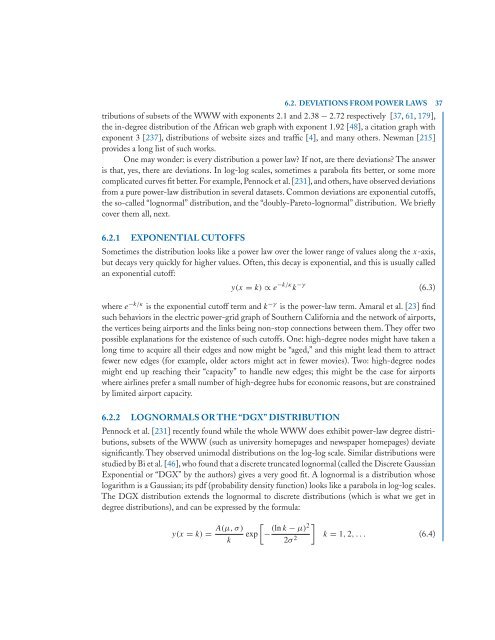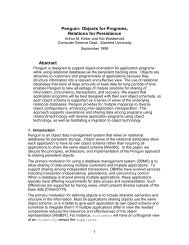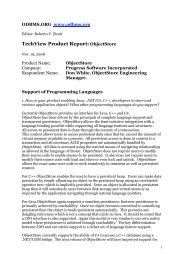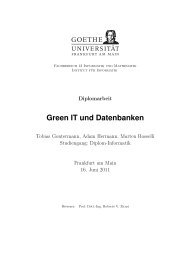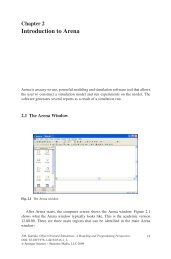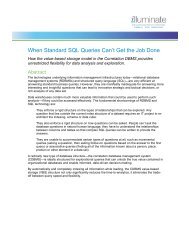Download Chapters 3-6 (.PDF) - ODBMS
Download Chapters 3-6 (.PDF) - ODBMS
Download Chapters 3-6 (.PDF) - ODBMS
Create successful ePaper yourself
Turn your PDF publications into a flip-book with our unique Google optimized e-Paper software.
6.2. DEVIATIONS FROM POWER LAWS 37<br />
tributions of subsets of the WWW with exponents 2.1 and 2.38 − 2.72 respectively [37, 61, 179],<br />
the in-degree distribution of the African web graph with exponent 1.92 [48], a citation graph with<br />
exponent 3 [237], distributions of website sizes and traffic [4], and many others. Newman [215]<br />
provides a long list of such works.<br />
One may wonder: is every distribution a power law? If not, are there deviations? The answer<br />
is that, yes, there are deviations. In log-log scales, sometimes a parabola fits better, or some more<br />
complicated curves fit better. For example, Pennock et al. [231], and others, have observed deviations<br />
from a pure power-law distribution in several datasets. Common deviations are exponential cutoffs,<br />
the so-called “lognormal” distribution, and the “doubly-Pareto-lognormal” distribution. We briefly<br />
cover them all, next.<br />
6.2.1 EXPONENTIAL CUTOFFS<br />
Sometimes the distribution looks like a power law over the lower range of values along the x-axis,<br />
but decays very quickly for higher values. Often, this decay is exponential, and this is usually called<br />
an exponential cutoff:<br />
y(x = k) ∝ e −k/κ k −γ<br />
(6.3)<br />
where e −k/κ is the exponential cutoff term and k −γ is the power-law term. Amaral et al. [23] find<br />
such behaviors in the electric power-grid graph of Southern California and the network of airports,<br />
the vertices being airports and the links being non-stop connections between them. They offer two<br />
possible explanations for the existence of such cutoffs. One: high-degree nodes might have taken a<br />
long time to acquire all their edges and now might be “aged,” and this might lead them to attract<br />
fewer new edges (for example, older actors might act in fewer movies). Two: high-degree nodes<br />
might end up reaching their “capacity” to handle new edges; this might be the case for airports<br />
where airlines prefer a small number of high-degree hubs for economic reasons, but are constrained<br />
by limited airport capacity.<br />
6.2.2 LOGNORMALS OR THE “DGX” DISTRIBUTION<br />
Pennock et al. [231] recently found while the whole WWW does exhibit power-law degree distributions,<br />
subsets of the WWW (such as university homepages and newspaper homepages) deviate<br />
significantly. They observed unimodal distributions on the log-log scale. Similar distributions were<br />
studied by Bi et al. [46], who found that a discrete truncated lognormal (called the Discrete Gaussian<br />
Exponential or “DGX” by the authors) gives a very good fit. A lognormal is a distribution whose<br />
logarithm is a Gaussian; its pdf (probability density function) looks like a parabola in log-log scales.<br />
The DGX distribution extends the lognormal to discrete distributions (which is what we get in<br />
degree distributions), and can be expressed by the formula:<br />
y(x = k) =<br />
A(μ, σ )<br />
k<br />
<br />
(ln k − μ)2<br />
exp −<br />
2σ 2<br />
<br />
k = 1, 2,... (6.4)


